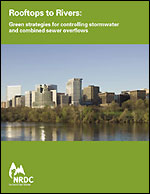Rooftops to Rivers: Green Infrastructure Strategies for Controlling Stormwater and Combined Sewer Overflows
Abstract
The urban landscape of roadways, sidewalks and buildings has changed the way water moves through our environment. Rain and snow that falls on paved surfaces becomes rainwater/stormwater runoff that picks up dirt and pollutants as it follows gravity downhill into storm drains and ultimately into streams, rivers and lakes; polluted runoff can threaten public health and degrade wildlife habitat.
Some cities are using green techniques — including rooftop gardens on city buildings, more absorbent concrete, and street planters that intercept rainwater before it hits the ground — to protect their water.
 Published by the National Resources Defense Council, this May 2006 report is a policy guide for decision makers looking to implement green strategies in their own area, including nine case studies of cities that have successfully used green techniques to create a healthier urban environment.
Published by the National Resources Defense Council, this May 2006 report is a policy guide for decision makers looking to implement green strategies in their own area, including nine case studies of cities that have successfully used green techniques to create a healthier urban environment.
To download a copy, click on Rooftops to Rivers: Green Infrastructure Strategies for Controlling Stormwater and Combined Sewer Overflows.
Case Studies
- Chicago, Illinois
- Milwaukee, Wisconsin
- Pittsburgh, Pennsylvania
- Portland, Oregon
- Rouge River Watershed, Michigan
- Seattle, Washington
- Toronto, Ontario, Canada
- Vancouver, B.C., Canada
- Washington, D.C.

